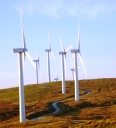
New Standard in the Works for Constructing, Demolishing Wind Turbines
With the growing national emphasis on "green" energy development and the potential risks involved in green energy-related construction operations, the American Society of Safety Engineers has announced a new A10 Accredited Standards Committee (ASC) project to develop a standard that will protect the safety and health of workers involved in construction and demolition operations for wind generation/turbine facilities.
During its January meeting, the A10 ASC committee approved the A10.21 subgroup to develop the standard, which will be called the "American National Standard for the Safe Construction and Demolition of Wind Generation/Turbine Facilities" (A10.21-20xx). Ryan J. Jacobson, P.E., manager of wind energy services for Black & Veatch, will serve as the subgroup chair, and Walter A. Jones, M.S., associate director, occupational safety and health for Laborers' Health & Safety Fund of North America, will serve as the A10.21 liaison, ASSE announced.
"The committee decided to develop this standard because of the national emphasis on green energy, recognizing that thousands of these 'green' structures are going to be built and, as such, present challenging safety and health issues," A10 Committee Chair Richard King said. "The purpose of the new standard is to sort out the safety and health issues and provide practical solutions to constructors."
Safety and health issues of concern during construction and demolition of wind generation/turbine facilities that the A10.21 subgroup will address in the development of the standard include working at heights, mechanical assembly of large components, medium voltage electrical safety, and working in exposed environments. The subgroup will cite and recognize other existing voluntary national consensus standards in the development process.
In addition, major construction tasks in a wind project that will be considered include: wind turbine assembly and erection; civil construction (roads and pad clearing); structural construction (foundations); placement of electrical collection system (buried medium voltage lines); and substation and transmission line construction. Major activities that also will be discussed include wind turbine generator component offloading; site staging; base tower section placement, which could include anchor bolt tensioning, leveling, and grouting; tower assembly; nacelle placement; rotor assembly (typically on the ground); rotor placement; and mechanical completion and commissioning.
ASSE serves as the secretariat for the A10 ASC on construction and demolition operations. The A10 standards serve as guides to contractors, labor, and equipment manufacturers in the construction and demolition industry.